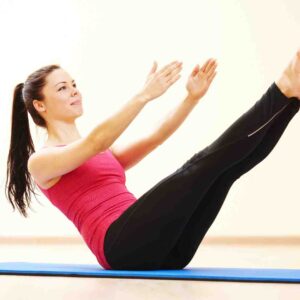Table of Contents
Introduction
5 Strength-Building Pilates Exercises
How Pilates Can Improve Your Strength Training Routine
Q&A Conclusion
"Pilates strength training transforms your body."
Introduction
Pilates strengthens core muscles. It builds muscle and fitness by employing resistance. Pilates uses resistance bands, weights, and exercise balls to target the abdominals, back, and hips. Pilates is a popular choice for people of all ages and fitness levels because it's low-impact and adaptable.

5 Strength-Building Pilates Exercises
Pilates has been popular for over a century. Joseph Pilates developed it, believing physical and mental health were linked. Pilates emphasises core strength, flexibility, and balance. Is Pilates strength training?
Yes, indeed. Pilates builds muscle with resistance. Pilates is not weightlifting. Pilates strengthens using body weight and springs and bands instead of heavy weights.
Five strength-building Pilates exercises:
1. The Hundred: This Pilates move works abs and arms. Lay on your back with bent knees and flat feet. Raise your head, shoulders, and arms. Pump your arms for five counts in and out. 10 sets, 100 pumps.
2. Single Leg Circles: Hips and thighs. Lay on your back with arms by your sides and legs straight up towards the ceiling. Circle one leg clockwise and anticlockwise five times. Alternate legs.
3. Plank: Core, arms, and shoulders. Start in a push-up position with your hands directly beneath your shoulders and feet hip-width apart. Hold this position for 30–60 seconds.
4. Side Plank: Works the side abs. From a plank posture, shift your weight to one hand and spin your body. Stack your feet and raise your top arm to the ceiling. Switch sides after 30–60 seconds.
5. Teaser: Abdominal and hip flexor exercise. Lay on your back with your arms overhead and your legs straight out. Reach your toes with your head, shoulders, and legs off the mat. Hold briefly, then lower.
Home or Pilates studio, these exercises can be customised for different fitness levels. Pilates is about strength, balance, flexibility, and posture.
Pilates movements increase muscle by using resistance. Pilates uses springs and bands to create strength, unlike typical strength training. Pilates improves strength and fitness.
Pilates Strength Training Benefits
Pilates is growing popularity. This low-impact workout strengthens core muscles, improves flexibility, and raises body awareness. Pilates is also a great strength training method.
Pilates strengthens the deep core muscles. These muscles stabilise the spine and pelvis, ensuring appropriate posture. Pilates strengthens these muscles to enhance alignment and reduce injury risk.
Pilates works the core, arms, legs, and back. Multi-muscle exercises can boost strength and endurance. Pilates uses tension bands and weights to challenge workouts.
Pilates for strength training is low-impact. Pilates is low-impact and helpful for persons with joint problems or injuries. It's also beneficial for senior folks searching for low-impact exercise to preserve strength and mobility.
Pilates can be tailored to individual fitness goals. Depending on fitness level, activities can be made easier or harder. Pilates is suitable for all fitness levels, from beginners to elite athletes.
Pilates has mental and physical benefits. Breathing and body awareness relieve stress and increase mental clarity. Pilates is also beneficial for meditative exercise.
Pilates is a good strength training method that improves the body and mind. It targets deep core, arm, leg, and back muscles. It's a customizable low-impact workout. It reduces stress and improves mental clarity. Pilates is a great option for strengthening and endurance or joint-friendly workout.
Strength Training with Pilates
Every workout needs strength training. It boosts bone density, muscle mass, and physical performance. Pilates as a strength training supplement is often overlooked. Pilates improves core strength, flexibility, and body awareness through low-impact exercises. Pilates can enhance your strength training and help you reach your fitness objectives.
Pilates improves posture and alignment. Poor posture can cause muscle imbalances, pain, and damage. Pilates strengthens spine-supporting muscles like the abdominals, back, and hips. Strength training injuries can be reduced through posture and alignment.
Pilates improves flexibility. Heavy weightlifting in strength training can tighten muscles and decrease range of motion. Pilates stretches and lengthens muscles, improving flexibility and reducing injury risk. Strength training with Pilates can increase your mobility and range of motion.
Pilates enhances bodily awareness. Many people lift weights without proper form. Poor results and damage risk can follow. Pilates improves body awareness and reduces injury risk through good alignment and technique. Pilates improves performance and results in strength training.
Fourth, Pilates improves concentration. Many strength training activities need mental attention. Pilates requires concentration and focus, which might increase mental clarity. Pilates can boost mental focus and strength training results.
Finally, Pilates boosts fitness. Pilates is low-impact and suitable for everyone. Pilates improves fitness and outcomes in strength training. Pilates reduces injury risk and speeds recovery, helping you reach your fitness objectives faster.
Finally, Pilates enhances strength training. It improves posture, alignment, flexibility, body awareness, mental focus, and fitness. Pilates improves strength training results and reduces injury risk. Pilates is a low-impact workout that everyone can do. Pilates can help you improve your strength training.
Q&A
Is Pilates strength training?
Pilates builds strength, flexibility, and endurance through regulated movements and resistance.
Can Pilates develop muscle?
Pilates may tone and sculpt muscles, especially in the core, arms, and legs, without increasing muscular mass.
3. How often should strength-training Pilates be done?
For effective strength training, Pilates should be done 2-3 times a week. However, fitness objectives and abilities determine Pilates frequency and intensity.
Conclusion
Conclusion: Pilates builds core strength, flexibility, and muscle tone. It may not grow muscular mass and strength as well as weightlifting. Pilates helps improve posture, balance, and body awareness in a well-rounded workout routine.


